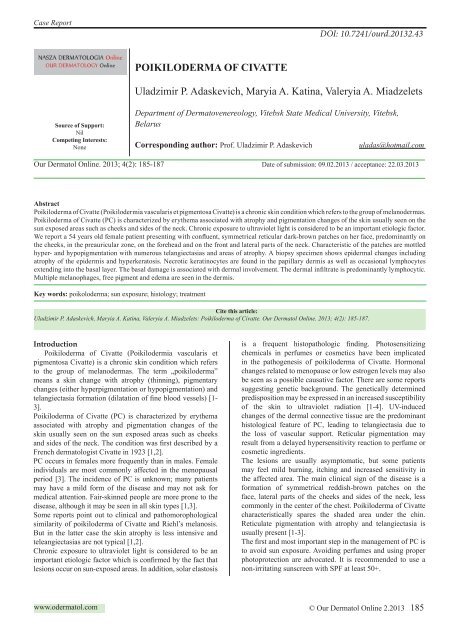download full issue - Our Dermatology Online Journal
download full issue - Our Dermatology Online Journal
download full issue - Our Dermatology Online Journal
You also want an ePaper? Increase the reach of your titles
YUMPU automatically turns print PDFs into web optimized ePapers that Google loves.
Case Report<br />
DOI: 10.7241/ourd.20132.43<br />
POIKILODERMA OF CIVATTE<br />
Uladzimir P. Adaskevich, Maryia A. Katina, Valeryia A. Miadzelets<br />
Source of Support:<br />
Nil<br />
Competing Interests:<br />
None<br />
Department of Dermatovenereology, Vitebsk State Medical University, Vitebsk,<br />
Belarus<br />
Corresponding author: Prof. Uladzimir P. Adaskevich<br />
uladas@hotmail.com<br />
<strong>Our</strong> Dermatol <strong>Online</strong>. 2013; 4(2): 185-187 Date of submission: 09.02.2013 / acceptance: 22.03.2013<br />
Abstract<br />
Poikiloderma of Civatte (Poikilodermia vascularis et pigmentosa Civatte) is a chronic skin condition which refers to the group of melanodermas.<br />
Poikiloderma of Civatte (PC) is characterized by erythema associated with atrophy and pigmentation changes of the skin usually seen on the<br />
sun exposed areas such as cheeks and sides of the neck. Chronic exposure to ultraviolet light is considered to be an important etiologic factor.<br />
We report a 54 years old female patient presenting with confluent, symmetrical reticular dark-brown patches on her face, predominantly on<br />
the cheeks, in the preauricular zone, on the forehead and on the front and lateral parts of the neck. Characteristic of the patches are mottled<br />
hyper- and hypopigmentation with numerous telangiectasias and areas of atrophy. A biopsy specimen shows epidermal changes including<br />
atrophy of the epidermis and hyperkeratosis. Necrotic keratinocytes are found in the papillary dermis as well as occasional lymphocytes<br />
extending into the basal layer. The basal damage is associated with dermal involvement. The dermal infiltrate is predominantly lymphocytic.<br />
Multiple melanophages, free pigment and edema are seen in the dermis.<br />
Key words: poikoloderma; sun exposure; histology; treatment<br />
Cite this article:<br />
Uladzimir P. Adaskevich, Maryia A. Katina, Valeryia A. Miadzelets: Poikiloderma of Civatte. <strong>Our</strong> Dermatol <strong>Online</strong>. 2013; 4(2): 185-187.<br />
Introduction<br />
Poikiloderma of Civatte (Poikilodermia vascularis et<br />
pigmentosa Civatte) is a chronic skin condition which refers<br />
to the group of melanodermas. The term „poikiloderma”<br />
means a skin change with atrophy (thinning), pigmentary<br />
changes (either hyperpigmentation or hypopigmentation) and<br />
telangiectasia formation (dilatation of fine blood vessels) [1-<br />
3].<br />
Poikiloderma of Civatte (PC) is characterized by erythema<br />
associated with atrophy and pigmentation changes of the<br />
skin usually seen on the sun exposed areas such as cheeks<br />
and sides of the neck. The condition was first described by a<br />
French dermatologist Civatte in 1923 [1,2].<br />
PC occurs in females more frequently than in males. Female<br />
individuals are most commonly affected in the menopausal<br />
period [3]. The incidence of PC is unknown; many patients<br />
may have a mild form of the disease and may not ask for<br />
medical attention. Fair-skinned people are more prone to the<br />
disease, although it may be seen in all skin types [1,3].<br />
Some reports point out to clinical and pathomorophological<br />
similarity of poikiloderma of Civatte and Riehl’s melanosis.<br />
But in the latter case the skin atrophy is less intensive and<br />
teleangiectasias are not typical [1,2].<br />
Chronic exposure to ultraviolet light is considered to be an<br />
important etiologic factor which is confirmed by the fact that<br />
lesions occur on sun-exposed areas. In addition, solar elastosis<br />
is a frequent histopathologic finding. Photosensitizing<br />
chemicals in perfumes or cosmetics have been implicated<br />
in the pathogenesis of poikiloderma of Civatte. Hormonal<br />
changes related to menopause or low estrogen levels may also<br />
be seen as a possible causative factor. There are some reports<br />
suggesting genetic background. The genetically determined<br />
predisposition may be expressed in an increased susceptibility<br />
of the skin to ultraviolet radiation [1-4]. UV-induced<br />
changes of the dermal connective t<strong>issue</strong> are the predominant<br />
histological feature of PC, leading to telangiectasia due to<br />
the loss of vascular support. Reticular pigmentation may<br />
result from a delayed hypersensitivity reaction to perfume or<br />
cosmetic ingredients.<br />
The lesions are usually asymptomatic, but some patients<br />
may feel mild burning, itching and increased sensitivity in<br />
the affected area. The main clinical sign of the disease is a<br />
formation of symmetrical reddish-brown patches on the<br />
face, lateral parts of the cheeks and sides of the neck, less<br />
commonly in the center of the chest. Poikiloderma of Civatte<br />
characteristically spares the shaded area under the chin.<br />
Reticulate pigmentation with atrophy and telangiectasia is<br />
usually present [1-3].<br />
The first and most important step in the management of PC is<br />
to avoid sun exposure. Avoiding perfumes and using proper<br />
photoprotection are advocated. It is recommended to use a<br />
non-irritating sunscreen with SPF at least 50+.<br />
www.odermatol.com<br />
© <strong>Our</strong> Dermatol <strong>Online</strong> 2.2013 185















